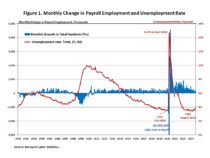The recent employment data indicates that the labor market is cooling gradually due to rising interest rates. Total employment increased by 187,000 and the unemployment rate rose to 3.8% from 3.5%. Wage growth slowed. In August, wages grew at a 4.3% year-over-year growth rate, down 1.1 percentage points from a 5.4% gain in August 2022.
The Bureau of Labor Statistics (BLS) announced the preliminary estimate of the annual benchmark revision, indicating March 2023 total nonfarm employment was revised down by 306,000 jobs, a 0.2% decrease from the previous release. Construction was revised up by 30,000 jobs, and manufacturing revised down by 43,000 jobs. The final revision will be issued in February 2024 with the publication of the January 2024 Employment Situation news release.

Total nonfarm payroll employment increased by 187,000 in August, following a gain of 157,000 in July, as reported in the Employment Situation Summary. The estimates for the previous two months were revised down. The estimate for June was revised lower by 80,000 from +185,000 to +105,000, while the July increase was revised down by 30,000, from +187,000 to +157,000. Despite restrictive monetary policy, nearly 5.4 million jobs have been created since March 2022, when the Fed enacted the first interest rate hike of this cycle. In the first eight months of 2023, nearly 1.9 million jobs were created, and monthly employment growth averaged 236,000 per month, following the average monthly growth of 399,000 in 2022.
The unemployment rate rose by 0.3 percentage points to 3.8% in August. The number of unemployed persons increased by 514,000 to nearly 6.4 million, while the number of employed persons increased by 222,000.
Meanwhile, the labor force participation rate, the proportion of the population either looking for a job or already holding a job, rose 0.2 percentage points to 62.8%. Moreover, the labor force participation rate for people who aged between 25 and 54 edged up 0.1 percentage point to 83.5%. While the overall labor force participation rate is still below its pre-pandemic levels at the beginning of 2020, the rate for people who aged between 25 and 54 exceeds the pre-pandemic level of 83.1%.

For industry sectors, employment in health care (+71,000), leisure and hospitality (+40,000), social assistance (+26,000), and construction (+22,000) continued to trend up in August, while transportation and warehousing lost 34,000 jobs.
Employment in the overall construction sector increased by 22,000 in August, following a 16,000 gain in July. While residential construction added 1,400 jobs, non-residential construction employment gained 21,000 jobs.
Residential construction employment now stands at 3.3 million in August, broken down as 925,000 builders and 2.4 million residential specialty trade contractors. The 6-month moving average of job gains for residential construction was 3,500 a month. Over the last 12 months, home builders and remodelers added 42,400 jobs on a net basis. Since the low point following the Great Recession, residential construction has gained 1,293,500 positions.
In August, the unemployment rate for construction workers rose by 0.4 percentage points to 4.9% on a seasonally adjusted basis. The unemployment rate for construction workers remained at a relatively lower level, after reaching 14.2% in April 2020, due to the housing demand impact of the COVID-19 pandemic.

Discover more from Eye On Housing
Subscribe to get the latest posts to your email.


Builders should closely monitor these labor market shifts, as they may impact project timelines and costs, potentially necessitating adjustments in construction loan terms to account for any workforce-related challenges.